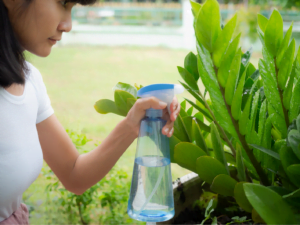
Even though they carry essentialness and magnificence to our inside spaces, indoor plants can be challenging to keep up with solid leaves. Since they are so critical to photosynthesis and breathing, solid leaves are essential to a plant’s general well-being. Here, we’ll take a gander at different methods and guidance for keeping indoor plant leaves solid so your plants develop well.
Understanding Plant Leaves
Photosynthesis, the cycle by which plants change light energy into compound energy to help their development, for the most part, happens in their leaves. Also, leaves assist in gas trading, empowering plants to breathe out oxygen and retain carbon dioxide. Accordingly, the plant’s ability to create and yield food is straightforwardly affected by the state of its leaves.
Types of Leaves
Indoor plants come with various types of leaves, each with specific care requirements. Some common types include:
- Broad Leaves: Shape and Structure: Albeit the morphology of expansive leaves could shift generally, they ordinarily have a wide, level surface. Ovoid (egg-molded), lanceolate (spear-formed), and palmate (like an open hand) are instances of normal shapes.
- Vein Patterns: Reticulate venation is the term for the net-like example that wide leaf veins regularly create. This differs from the equal venation that numerous monocots have.
- Size: Contingent upon the species, expansive leaves can be anyplace in size from a couple of centimeters to a few meters. A regular nursery blossom’s leaves could be a couple of centimeters long, though those of a banana plant can arrive at a few meters in length.
- Texture: Expansive leaves could have tiny scopes covering them, and be bristly, waxy, or smooth. By limiting water misfortune, these surfaces can help with the plant’s natural variation or deflect herbivores.
Functions of Broad Leaves
- Photosynthesis: The primary function of broad leaves is to capture sunlight for photosynthesis. Their large surface area allows for maximum light absorption.
- Gas Exchange: The small openings on the underside of leaves, called stomata, permit gases from the plant and the climate to trade, including carbon dioxide and oxygen..
- Transpiration: Happening, the interaction by which water is lost from the plant to the air, is incredibly supported by wide leaves. This guides in temperature guidelines and supplement assimilation.
Adaptations
To assist plants with flourishing in different circumstances, expansive leaves have developed a few variations:
- Tropical Rainforests: Wide leaves in these spots are habitually huge, shiny, and have trickle focuses to let out additional water.
- Deciduous Forests: To safeguard water for the colder time of year, the trees in these woods shed their huge leaves in the fall.
- Arid Regions: In parched environments, a few broadleaf plants produce thick, waxy leaves to forestall water misfortune.
Examples of Broadleaf Plants
- Trees: Oak, Maple, Birch, and Eucalyptus
- Shrubs: Rhododendron, Holly, and Azalea
- Herbaceous Plants: Sunflowers, Dandelions, and Hostess
Ecological Importance
Their natural surroundings benefit incredibly from the presence of wide leaves:
- Habitat: For some bugs, birds, and creatures, they offer food and territory.
- Soil Health: Falling leaves further develop soil richness by adding to the natural matter in the dirt.
- Climate Regulation: Broadleaf plants add to the guideline of neighborhood temperature conditions and barometrical CO2 levels through happening and photosynthesis.
Narrow Leaves: Characteristics of Narrow Leaves
- Shape and Size Commonly, restricted leaves are long and dainty, similar to a needle or spear. Their length and width can change, however they generally have a tight profile.
- Texture and Veining Contingent upon the sort of plant, dainty leaves can have a smooth or fairly unpleasant feel. tight veins to give compelling supplement move and underlying scaffolding leaves as often as possible run equal..
- Arrangement: Contingent upon the sort of plant, restricted leaves might be assembled around the stem whorled, inverse, or on the other hand.
Adaptive Advantages
- Water Conservation: These leaves’ thin structure limits water misfortune through happening by lessening surface region. This versatility is especially valuable in dry or desert conditions.
- Wind Resistance: Solid breezes are less inclined to harm thin leaves due to their more modest surface region and more prominent adaptability. This makes them proper for plants that are filled in blustery conditions.
- Light Penetration: Limited leaves in thick timberlands or obscure regions permit all the more light to arrive at the lower leaves and encompassing plants, which upgrades the overall well-being and development of the plants.
- Heat Dissipation: The thin plan supports better intensity scattering, abstaining from overheating, and safeguarding the ideal temperature for photosynthesis on leaves.
Examples of Plants with Narrow Leaves
- Grasses The leaves of most grass species, like wheat and bamboo, are tight. These leaves are great at clutching water and engrossing daylight.
- Conifers: The thin, needle-like leaves of trees like tidies, pines, and firs are great for chilly, dry climes. These needles’ waxy covering further limits water misfortune.
- Eucalyptus: The fragrant oils on eucalyptus trees, which are recognized by their long, slim passes on and capacity to oppose dryness, act as an impediment to herbivores.
- Lavender: This fragrant plant fills well in Mediterranean settings and has restricted, direct leaves that help forestall water misfortune.
- Oleander: Regularly found in warm environments, oleander plants have lanceolate leaves that are powerful in photosynthesis and impervious to dryness.
Succulent Leaves: Characteristics
- Water Storage: Since delicious leaves are made to hold water, the plant can endure extended droughts. Having the option to store energy is fundamental for making due in dry regions.
- Thick and Fleshy: When contrasted with different plants, the leaves are observably thick and substantial. This is because there are certain cells there that can store water.
- Waxy or Powdery Coating: The fingernail skin, a waxy or fine covering on numerous delicious leaves, limits happening and subsequently forestall water misfortune.
- Varied Shapes and Sizes: Delicious leaves are tracked down in various sizes and styles, including round, stretched, and rosettes. Their versatility in different natural surroundings and tasteful allure are improved by their variety.
- Color Variation: Delicious leaves arrive in various tints, going from distinctive reds, purples, and blues to profound greens. These tints could move in light of the environmental elements conditions like daylight and the accessibility of water.
Adaptations
- Crassulacean Acid Metabolism (CAM): A ton of succulents use CAM photosynthesis, which empowers them to proceed with photosynthesis over the day while opening their stomata around evening time to decrease water misfortune.
- Reduced Leaf Surface Area Certain succulents limit water misfortune by having leaves that are either absent or have a more modest surface region. In these plants, photosynthetic cycles are oftentimes taken over by the stem.
- Spines and Trichomes: Certain succulents have spines or trichomes, which look like hair and shade the leaf surface to keep water misfortune and give assurance from herbivores.
Types of Succulent Leaves
- Rosette Forming: Sempervivum and Echeveria are two models. The rosette-molded leaves on these succulents are organized in a round design.
- Tubular or Cylindrical: Haworthia and Senecio are two models. The stretched, tube-like leaves of these succulents limit water misfortune and surface region.
- Flattened or Paddle-shaped: Aeonium and kalanchoe are two models. These succulents have enormous, level leaves that can retain all the more light, yet they’ve likewise advanced to lose as little water as could be expected.
Common Succulent Genera
- Aloe: Aloe leaves are thick, substantial, and have sharp edges. They are notable for their restorative purposes.
- Sedum: These are regularly used as ground cover due to their little, circular leaves that fill in thick bunches.
- Crassula: The notable jade plant, which has thick, lustrous leaves, has a place in this class
- Echeveria: Well known in decorative cultivating, they are rosette-framing succulents that arrive in a large number of varieties and shapes.
- Agave: Agaves are ordinarily used in arranging in light of their capacity to hold water well and their enormous, thorny leaves.
Care Tips
- Watering: Use water sparingly and ensure seepage is sufficient. To keep away from root decay, let the dirt dry in the middle between waterings.
- Light: Ensure there is sufficient daylight — in a perfect world six hours daily in direct daylight. While specific succulents might get by with less light, their development might be restricted.
- Soil: Utilize a delicious or prickly plant blend that has well-emptying soil to keep water out of pooling around the roots.
- Temperature: Succulents might make due in different conditions, even though they for the most part like warm climates. Guard them from harsh cold and ice.
- Fertilization: Apply irregular, adjusted, weakened manure, ideally in the spring and summer while plants are developing.
Understanding what sort of leaves your indoor plant has will assist you with changing your consideration routine to suit their necessities.
Proper Lighting

The course of photosynthesis requires light. While a lot of light can singe leaves, insufficient light can make them look feeble and pale.
Natural Light
- Direct Sunlight: proper for succulents and prickly plants.
- Indirect Sunlight: ideal for most houseplants. Put them facing sifted light windows.
- Low Light: Certain plants, for example, the ZZ Plant, can get by in low light.
Artificial Light
Use develop lights if there isn’t sufficient regular light. Energy-productive development lights might be acclimated to transmit the best light range for plant development.
Watering

A enough water system is crucial for keeping leaves solid. Harm to leaves can result from both under-watering and overwatering.
Tips for Watering
- Check Soil Moisture: Before watering, check the dampness content of the dirt with your finger or a dampness meter.
- Watering Frequency: Adjust to the kind of plant, the season, and the mugginess levels inside the space.
- Water Quality: To keep hurt from fluoride and chlorine, utilize sifted water at room temperature.
Signs of Watering Issues
- Overwatering: Soft stems, yellowing leaves, and root decay.
- Under watering: Shriveling, crunchy, earthy colored leaves.
Humidity
Numerous tropical spots with high stickiness levels are the wellspring of indoor plants. For their well-being, keeping up with the right stickiness levels is urgent.
Increasing Humidity
- Misting: Splash a little water on the leaves.
- Humidity Trays: Under the plant pot, place a plate with stones and water on it.
- Humidifiers: To keep stickiness levels consistent, utilize a humidifier.
Signs of Low Humidity
Leaf tips and edges that are dry and brown recommend low dampness.
Temperature

Indoor plants require a specific scope of temperatures to develop. Plants under pressure and with harmed leaves could result from unexpected temperature variances.
Ideal Temperature Range
The ideal temperature range for most indoor plants is 65°F to 75°F (18°C to 24°C).
Tips for Temperature Control
- Avoid Drafts: Plants ought not to be close to warming vents or drafts.
- Consistent Temperature: Keep the temperature range consistent.
Soil and Fertilization
For ideal leaf development, the right soil and compost strategies are required
Soil
For indoor plants, use gardening soil that channels well. Root decay and foliage harm can result from lacking waste.
Fertilization
- Balanced Fertilizer: During the developing season, utilize a water-dissolvable manure that is adjusted (spring and summer).
- Frequency: During the developing season, treat each four to about a month and a half; during the lethargic season (pre-winter and winter), prepare less as often as possible).
Signs of Nutrient Deficiency
An absence of supplements is shown by yellowing leaves, diminished development, and unfortunate leaf improvement.
Pruning and Cleaning
Plant magnificence and leaf well-being can be saved with standard pruning and cleaning.
Pruning
- Remove Dead Leaves: To stop the spread of sickness, eliminate any dead or yellowing leaves.
- Encourage Growth: Trim thin development to advance more shaggy plants..
Cleaning
- Dusting: To dispose of residue, delicately clean leaves with a wet material.
- Pest Inspection: Check for bugs like aphids and bug parasites consistently.
Common Pests and Diseases
Illnesses and bugs can adversely affect leaf wellbeing. Early analysis and mediation are fundamental.
Common Pests
- Spider Mites: Small red nuisances that actuate staining on leaves and webbing.
- Aphids: Bugs, close to nothing, green or dark, that feed on leaf sap.
- Mealybugs: Bothers that look like cotton and are white, assembled on leaves and stems
Treatment
- Neem Oil: To treat and forestall bother invasions, use neem oil splash.
- Insecticidal Soap: On the impacted locales, utilize insecticidal cleanser..
Common Diseases
- Powdery Mildew: Spots of white powder on leaves.
- Leaf Spot: Spots of dark or brown on leaves.
Treatment
- Fungicides: To fix parasitic contaminations, apply fungicides.
- Proper Air Circulation: To prevent parasites from developing around plants, ensure there is a satisfactory wind current.
Repotting
At the point when the plant grows out of its pot or the dirt gets excessively flimsy, repotting is required.
When to Repot
- Root Bound: Roots jutting from the holes for waste.
- Soil Degradation: soil that has lost its capacity to hold dampness and supplements.
How to Report
- Choose the Right Pot: Pick a pot that is 1-2 inches greater in measurement than the one you have.
- Fresh Soil: Utilize new gardening soil that channels pleasantly.
- Gentle Handling: Tenderly handle roots to forestall hurt.
Specialized Care for Specific Plants
Each plant has various necessities for support. Here are a few pointers for popular houseplants.
Fiddle Leaf Fig
- Light: roundabout light that is brilliant
- Watering: Apply water when the dirt’s top inch becomes dry.
- Humidity: High relative moistness.
Snake Plant
- Light: Circuitous light, from faint to brilliant.
- Watering: Water rarely; let the dirt in the middle between applications.
- Humidity: The common moistness inside.
Peace Lily
- Light: Roundabout light, from faint to splendid.
- Watering: Ensure the dirt is consistently wet.
- Humidity: H High relative stickiness.
Spider Plant
- Light: bright, backhanded light
- Watering: Apply water when the dirt’s top inch becomes dry.
- Humidity: Dampness range: normal to high.
Monitoring and Adjusting Care
Regular monitoring and adjusting care routines are essential for maintaining healthy leaves.
Observation
- Check Leaves: Regularly inspect leaves for signs of stress or pests.
- Monitor Growth: Note any changes in growth patterns.
Adjusting Care
- Seasonal Changes: Adjust watering and lighting based on seasonal changes.
- Environmental Factors: Consider factors like indoor heating and cooling.
Creating a Healthy Environment
A healthy environment is key to maintaining healthy leaves.
Air Quality
Good air quality is essential for plant health.
- Ventilation: Ensure good air circulation around plants.
- Air Purifiers: Use air purifiers to reduce pollutants.
Plant Placement
- Avoid Clutter: Avoid placing plants too close together to ensure good air circulation.
- Proper Positioning: Position plants based on their light requirements.
Stress Reduction
- Consistent Care: Maintain a consistent care routine to reduce plant stress.
- Gradual Changes: Make gradual changes to the plant’s environment to avoid shock.
Numerous plants, such as light, water, mugginess, temperature, soil, and bugs, should be thought about to keep up with the soundness of indoor plant leaves. You can ensure that your indoor plants thrive and add magnificence and energy to your living regions by monitoring their interesting requests and keeping a fitting climate. Keeping up with solid leaves and general plant well-being requires intermittent perception, fitting consideration practices, and brief changes. These strategies and counsel will assist you with developing rich, brilliant indoor plants, no matter what your degree of involvement.

